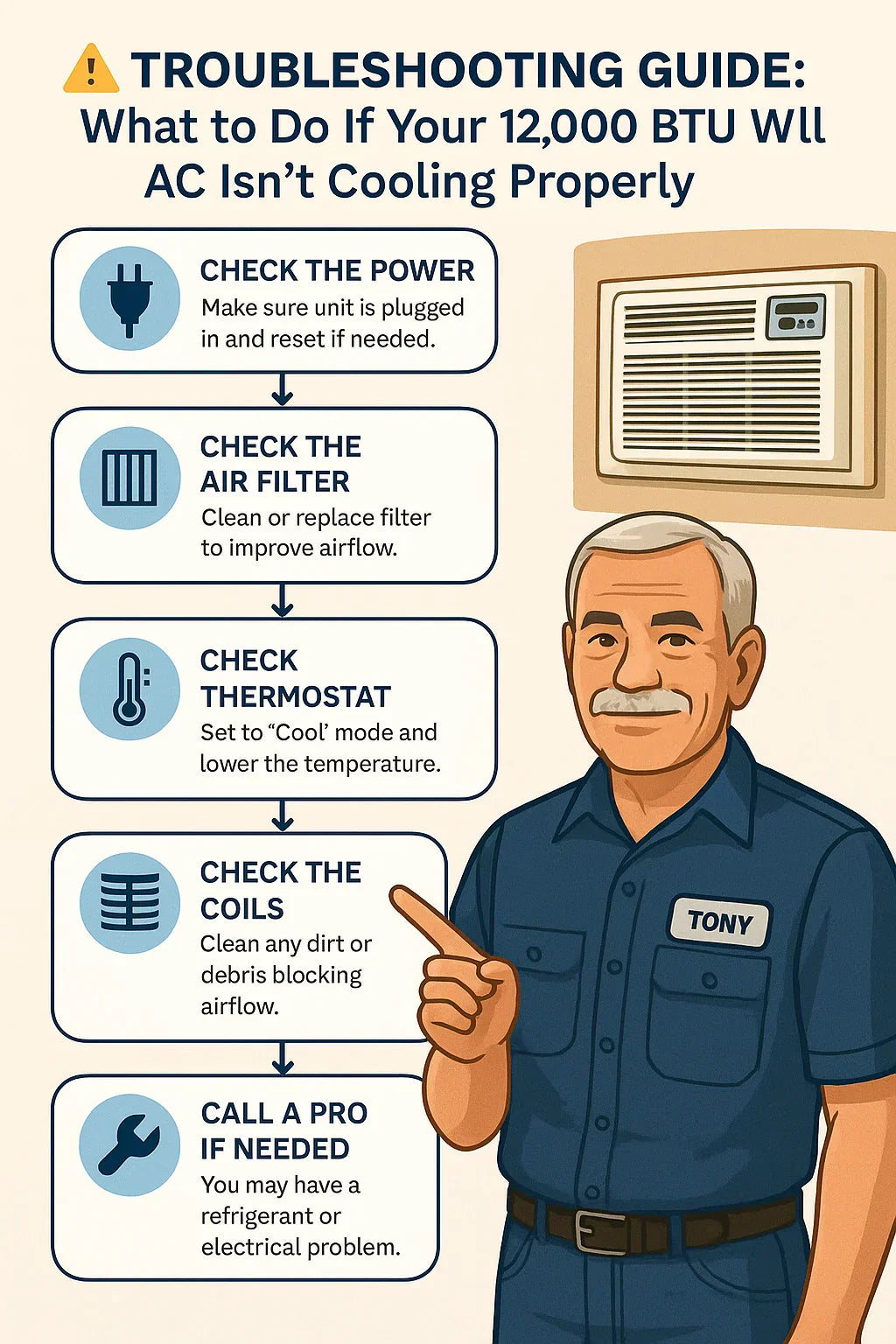By Tony Marino — DIY homeowner helping families keep their wall ACs running smoothly.
📘 Introduction
There’s nothing worse than walking into your living room on a sweltering July day, only to find your 12,000 BTU through‑the‑wall AC blowing warm air.
I’ve been there. My unit once quit cooling right before a family barbecue. Luckily, instead of calling a pro right away, I ran through a troubleshooting checklist — and fixed the issue myself in under an hour (a clogged filter).
This guide will walk you through step‑by‑step solutions for the most common reasons your wall AC isn’t cooling properly — plus when it’s time to stop tinkering and call in a professional.
🧹 1. Start with the Basics
Before grabbing your toolbox, double‑check the simple things.
✅ Check the Power
-
Ensure the unit is plugged into a grounded outlet.
-
Inspect the circuit breaker or fuse box.
-
Test the remote control batteries.
✅ Reset the Unit
-
Many wall ACs have a reset button near the plug.
-
If not, unplug for 5 minutes, then restart.
Tony’s Tip: Sometimes a tripped breaker or power surge is the only culprit.
🧽 2. Inspect & Clean the Air Filter
A dirty filter is the #1 cause of poor cooling.
🔍 Signs of a Dirty Filter
-
Weak airflow
-
Dust on vents
-
Higher energy bills
-
Musty smell
🛠️ How to Fix
-
Turn off and unplug the unit.
-
Remove the filter from behind the front grille.
-
Rinse under lukewarm water.
-
Let it air dry completely before reinserting.
-
Replace if damaged or discolored.
📅 Do this monthly during heavy use.
👉 Learn more at Energy Star Filter Tips.
🌬️ 3. Verify Thermostat Settings
Sometimes the “problem” is just a setting.
✅ Checklist
-
Ensure Mode is set to Cool (not Fan or Dry).
-
Lower temperature at least 5°F below room temperature.
-
Check if Eco Mode or Energy Saver is reducing performance.
-
For Wi‑Fi units, ensure no app or smart home setting is overriding manual controls.
Tony’s Example:
“My nephew once set the unit to ‘Fan Only’ by accident. It took me 15 minutes to realize why the air wasn’t cold!”
🌀 4. Inspect Airflow & Vents
Airflow issues can make a powerful AC feel weak.
🚫 Common Blockages
-
Curtains or furniture blocking vents.
-
Outdoor exhaust blocked by leaves or debris.
-
Wall sleeve clogged with insulation, dirt, or even pests.
🛠️ Fix
-
Move obstructions at least 3 feet away from vents.
-
Clean the outdoor grille with a brush.
-
Vacuum inside the sleeve carefully.
👉 U.S. Department of Energy recommends keeping airflow pathways clear for optimal performance.
🧯 5. Clean the Coils
Dusty coils make your AC work twice as hard.
📌 Types of Coils
-
Evaporator Coil (inside): absorbs heat.
-
Condenser Coil (outside): releases heat outdoors.
🛠️ Cleaning Steps
-
Power off and unplug the unit.
-
Remove the front cover.
-
Use a soft brush to remove surface dust.
-
Spray with coil cleaner.
-
Let sit, then rinse gently with water.
-
Dry fully before restarting.
Frequency: Twice per year (spring & fall).
💧 6. Check the Drain Line & Pan
If water isn’t draining, it can cause cooling problems.
🔍 Signs of Clogs
-
Water pooling near the unit
-
Musty smell indoors
-
Weak cooling
🛠️ Fix
-
Locate the drain line (usually a small PVC pipe).
-
Insert a pipe cleaner or thin brush.
-
Flush with a vinegar solution.
-
Ensure the sleeve is tilted slightly outward for drainage.
👉 HVAC.com suggests monthly checks in humid climates.
🔌 7. Electrical & Mechanical Issues
⚡ Electrical
-
Inspect the cord for frays.
-
Ensure outlet is grounded.
-
Test GFCI if applicable.
⚙️ Mechanical
-
Fan not spinning? Check for obstructions.
-
Strange noises? Tighten screws or add foam insulation.
-
No cooling but fan runs? Likely refrigerant — requires a pro.
❄️ 8. Signs of Refrigerant Problems (Call a Pro)
Refrigerant issues are not DIY‑friendly.
🔍 Warning Signs
-
AC runs but blows warm air.
-
Hissing or bubbling sounds.
-
Ice forming on coils.
-
Unit short‑cycles (turns on and off rapidly).
🧰 9. Seasonal Preventive Maintenance
A proactive approach keeps problems from happening.
🌸 Spring
-
Clean coils and filters.
-
Seal cracks around the wall sleeve.
-
Test unit for 30 minutes.
☀️ Summer
-
Clean filters monthly.
-
Check drain line for clogs.
-
Listen for unusual sounds.
🍂 Fall
-
Deep clean filters and coils.
-
Remove outdoor debris.
-
Inspect for water damage.
❄️ Winter
-
Cover the exterior with a breathable AC cover.
-
Unplug if not in use.
-
Insulate sleeve to reduce drafts.
🧠 10. When to Call a Professional
Even Tony knows when to call it quits.
📌 Call a Pro If:
-
Unit trips the breaker repeatedly.
-
Strange burning smells occur.
-
Refrigerant issues suspected.
-
Unit is over 10 years old and frequently failing.
⭐ Tony’s Final Advice
Most AC issues aren’t catastrophic. Start simple, check airflow, clean filters, and look for clogs.
“The majority of cooling problems I see come down to neglect. A filter cleaning or a coil rinse can save you from a $200 service call.”
Tony’s Quick Fix Checklist:
-
✅ Check power & reset unit
-
✅ Clean or replace filter
-
✅ Confirm thermostat is on Cool
-
✅ Clear vents and check coils
-
✅ Clean drain line & pan
-
✅ Call a pro if refrigerant is the issue
👉 Browse 12k BTU Through‑the‑Wall ACs designed for easier DIY maintenance.
In the next topic we will know more about: Noise, Clearance, and Placement: Where Tony Installed His Through-the-Wall AC for Best Results







